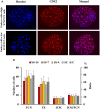A Short-Term Altrenogest Treatment Post-weaning Followed by Superovulation Reduces Pregnancy Rates and Embryo Production Efficiency in Multiparous Sows
- PMID: 34869743
- PMCID: PMC8637542
- DOI: 10.3389/fvets.2021.771573
A Short-Term Altrenogest Treatment Post-weaning Followed by Superovulation Reduces Pregnancy Rates and Embryo Production Efficiency in Multiparous Sows
Abstract
Although embryo transfer (ET) is a biotechnology ready for the swine industry, there are factors to be solved, the availability of embryo donors as one. Multiparous sows as donors ought to be considered since weaning is a natural and efficient method for estrus synchronization. In addition, superovulation treatments at weaning are effective in increasing the efficiency of donor embryo production. However, ET programs typically require more donors than those available from a single weaning, imposing grouping several weanings to establish a batch for ET. Since short-term administration of Altrenogest is effective in delaying estrus after weaning without effects on ovulation and embryo development, we investigated how Altrenogest combined with superovulation would affect reproductive parameters and embryo quality and quantity of weaned multiparous donor sows. The sows were administered Altrenogest from the day of weaning for 14 (SS-14 group; N = 26), 7 (SS-7 group; N = 31) and 4 (SS-4 group; N = 32) days. The sows were superovulated with eCG 24 h after the last administration of Altrenogest and with hCG at the onset of estrus. Sows not treated with Altrenogest that were superovulated with eCG 24 h post-weaning and hCG at the onset of estrus (SC group; N = 37) and sows with natural estrus after weaning (C group; N = 34) were used as control groups. The percentage of sows showing estrus within 10 days was not affected by the treatment, but the interval from Altrenogest withdrawal to estrus was longer (P < 0.05) in the SS groups than the interval from weaning to estrus in the controls. SS treatments increased (P < 0.05) the percentage of sows with ovarian cysts and the development of polycystic ovaries. The pregnancy and the fertilization rates, and the overall embryo production efficiency were also negatively affected by the SS treatments (P < 0.05). Interestingly, almost 70% of the structures classified as unfertilized oocytes or degenerated embryos in sows from the SS groups were immature oocytes. In conclusion, although superovulation of weaned sows was highly efficient, short-term administration of Altrenogest in combination with superovulation had negative effects on most of the reproductive parameters assessed, particularly affecting the overall efficiency of pregnancy and embryo production.
Keywords: Altrenogest; embryo; embryo transfer; estrus synchronization; pig; superovulation; weaning.
Copyright © 2021 Gonzalez-Ramiro, Cuello, Cambra, Gonzalez-Plaza, Vazquez, Vazquez, Rodriguez-Martinez, Gil, Lucas-Sanchez, Parrilla and Martinez.
Conflict of interest statement
The authors declare that the research was conducted in the absence of any commercial or financial relationships that could be construed as a potential conflict of interest.
Figures






Similar articles
-
Combined synchronization and superovulation treatments negatively impact embryo viability possibly by the downregulation of WNT/β-catenin and Notch signaling genes in the porcine endometrium.J Anim Sci. 2022 Nov 1;100(11):skac315. doi: 10.1093/jas/skac315. J Anim Sci. 2022. PMID: 36169657 Free PMC article.
-
The Use of a Brief Synchronization Treatment after Weaning, Combined with Superovulation, Has Moderate Effects on the Gene Expression of Surviving Pig Blastocysts.Animals (Basel). 2023 May 8;13(9):1568. doi: 10.3390/ani13091568. Animals (Basel). 2023. PMID: 37174605 Free PMC article.
-
The effects of superovulation of donor sows on ovarian response and embryo development after nonsurgical deep-uterine embryo transfer.Theriogenology. 2014 Apr 1;81(6):832-9. doi: 10.1016/j.theriogenology.2013.12.017. Epub 2013 Dec 28. Theriogenology. 2014. PMID: 24462299
-
Control of estrus and ovulation: Fertility to timed insemination of gilts and sows.Theriogenology. 2016 Oct 1;86(6):1460-1466. doi: 10.1016/j.theriogenology.2016.04.089. Epub 2016 May 14. Theriogenology. 2016. PMID: 27287469 Review.
-
Effects of altrenogest on reproductive performance of gilts and sows: A meta-analysis.Anim Reprod Sci. 2018 Oct;197:10-21. doi: 10.1016/j.anireprosci.2018.08.035. Epub 2018 Aug 30. Anim Reprod Sci. 2018. PMID: 30197055 Review.
Cited by
-
Combined synchronization and superovulation treatments negatively impact embryo viability possibly by the downregulation of WNT/β-catenin and Notch signaling genes in the porcine endometrium.J Anim Sci. 2022 Nov 1;100(11):skac315. doi: 10.1093/jas/skac315. J Anim Sci. 2022. PMID: 36169657 Free PMC article.
-
The Use of a Brief Synchronization Treatment after Weaning, Combined with Superovulation, Has Moderate Effects on the Gene Expression of Surviving Pig Blastocysts.Animals (Basel). 2023 May 8;13(9):1568. doi: 10.3390/ani13091568. Animals (Basel). 2023. PMID: 37174605 Free PMC article.
-
Immunological uterine response to pig embryos before and during implantation.Reprod Domest Anim. 2022 Oct;57 Suppl 5(Suppl 5):4-13. doi: 10.1111/rda.14142. Epub 2022 May 15. Reprod Domest Anim. 2022. PMID: 35500162 Free PMC article. Review.

